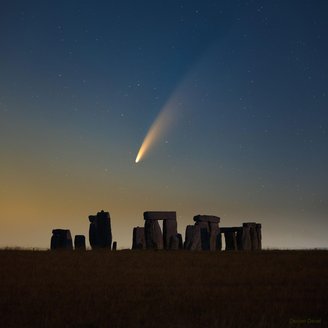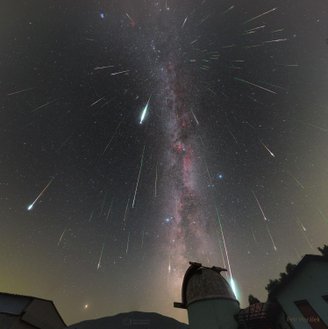Astronomy and skygazing enthusiasts will be in for plenty of surprises next year as a series of wonders light up the skies of 2024!
Among the main attractions that will fascinate millions of people around the world are two penumbra lunar eclipses. total solar eclipse, a series of spectacular meteor showers, the passage of two comets, and beautiful planetary conjunctions!
Astronomical Calendar 2024
We’ve put together a roundup of next year’s best sky shows for you to mark your calendar and get your observing tools ready. Take a look at what awaits us!
Eclipses
Mother The celestial event of the year will be a total solar eclipse As the Moon completely covers the Sun’s disk, it’s a sight that will darken the sky for millions of observers in North America.
This event will occur on April 8 and unfortunately will not be visible from Brazil, as the path of the lunar shadow, in which the entire Sun’s disk is blocked by the Moon, will only cover Mexico, the United States and Canada. .
But the audience In Brazil, you will be able to witness two penumbra lunar eclipses, the first on March 25 and the second on September 17.. This phenomenon occurs when the Moon is in the twilight zone of the Earth’s shadow. The result is a slight but noticeable decrease in the Moon’s brightness.
Passing of comets

One of the most famous events among those who love the night sky Transitions of comets between stars and the year 2024We will have not one but two comet passes in the skies!
The first is a giant comet, Three times the size of Mount Everest and called 12P/Pons-Brooks, it is hurtling towards the inner Solar System.. The comet, which consists mostly of ice, dust and gas, is expected to show a rapid increase in brightness this year, and as it approaches the Sun in March, this brightness is expected to continue to increase significantly until it becomes visible to the naked eye. In April.
An interesting estimated date to look for it in the sky is April 12, just after sunset, when the comet will appear to pass close to bright Jupiter, making it easier to follow. Nine days later, on April 21, Comet Pons-Brooks will reach its closest point to the Sun and reach its maximum brightness, providing one of the best opportunities for observation.
Second Comet A3 Tsuchinshan-ATLAS, which was first detected in February this year, is expected to become an impressive sight in late 2024.. At the beginning of winter in the Southern Hemisphere, it will be visible in the night sky as its orbit will bring it closer to the Sun and Earth for the first time in 80,000 years.
Astronomers expect it to increase in brightness, possibly be visible through binoculars or the naked eye, and appear low in the eastern sky before sunrise at southern latitudes.
meteor shower

Right at the beginning of the year, on the night and early morning of January 3 and 4, respectively, Peak activity of the Quadrantid meteor showerA medium-sized event that can produce approximately 40 meteors per hour. The shower consists of the remnants of an extinct comet called 2003 EH1 and occurs between January 1 and 5 each year.
Another average meteor shower An event called the Lyrid will occur, produced by dust particles left behind by comet C/1861 G1 Thatcher. It always occurs between April 16 and 25. Next year, peak activity, which will produce up to 20 meteors per hour, is expected to occur on the night of the 22nd and the morning of the 23rd.
However, heavy rains will occur later in the year. The Perseids, one of the best meteor showers to observer produces up to 60 meteors per hour at its peak, predicted for August 12 and 13, and is caused by debris left behind by Comet Swift-Tuttle.
The best rain of the year is expected to peak on December 13 and 14: The Geminids will be the main meteor event of the year, producing up to 120 colorful meteors per hour at their peak. It originates from debris left behind by asteroid 3200 Phaethon and occurs every year between December 7 and 17.
Planetary conjunctions
A planetary conjunction occurs when two or more planets appear close together in the sky. And we will have the year 2024 Rare Jupiter-Uranus conjunction on April 20It’s an event that happens every 14 years. Other conjunctions of the year are as follows:
- February 22, 2024: Venus-Mars;
- March 21, 2024: Venus-Saturn;
- April 3, 2024: Venus-Neptune;
- April 10, 2024: Mars-Saturn;
- April 29, 2024: Mars-Neptune;
- May 31, 2024: Mercury-Uranus;
- June 4, 2024: Jupiter-Mercury;
- July 15, 2024: Mars-Uranus;
- August 7, 2024: Mercury-Venus;
- August 14, 2024: Mars-Jupiter.
Always be informed about all the celestial events of 2024 on TecMundo and get the opportunity to share the year’s calendar with your friends!
Source: Tec Mundo
I’m Blaine Morgan, an experienced journalist and writer with over 8 years of experience in the tech industry. My expertise lies in writing about technology news and trends, covering everything from cutting-edge gadgets to emerging software developments. I’ve written for several leading publications including Gadget Onus where I am an author.












